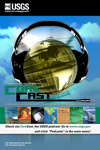USGS CoreCast
USGS Podcasts Home > CoreCast Home Page
Can't see Flash? Install Flash Player.
|
98
|

A roundup of the April and May 2009 hazard-related events around the world, with some newsworthy tidbits.
Type: audio/mpeg
File Size: 4499971 bytes Duration: 4:36 Released: Thu, 4 Jun 2009 19:29:52 UTC |
Transcript:
Welcome, and thanks for tuning into the USGS Hazards Roundup for April and May, 2009. My name is Brian Campbell, your host.
It has been a hazards-filled and busy two months for the USGS. The threat posed by record-breaking flooding and ice jams in the interior of Alaska kept USGS hydrologists busy while their counterparts there in the geosciences were kept wondering whether recent increases in seismic activity at Mt. Redoubt were indicative of another explosive event in the near future. Meanwhile, deadly earthquakes in Italy and Honduras made international headlines while an earthquake in the heart of Los Angeles was felt by thousands. Let’s get into it…
Heavier-than-usual winter snowfall and above-average spring temperatures proved to be a hazardous combination for Interior Alaska over the course of the past two months, resulting in heavy flooding, further exacerbated in some areas by the formation of ice jams. The flooding began at the end of April, in the Tanana River Valley, when an ice jam temporarily dammed the river, flooding the surrounding, low-lying areas. Flooding continued into May and proved to be catastrophic in certain places. The villages of Eagle and Fortymile Village were nearly destroyed. USGS crews worked persistently throughout the flooding, repairing damaged streamgages to ensure that timely and accurate data collection was taking place.
Flooding was not the only hazard facing the state of Alaska in April and May. The volcano, Mt. Redoubt, continues to remain active and is keeping USGS scientists on their toes, especially with the renewed onset of seismic activity at the volcano on May 2nd and the continued growth of the lava dome in the summit crater. Since the March 23rd eruption, Mt. Redoubt has had a number of other explosive events, including a significant event on April 4th that sent ash and steam 50,000 ft. into the air and generated a lahar down the Drift River. USGS scientists at the Alaska Volcano Observatory, recognizing the threat that the lahar posed to employees at the Drift River Oil Terminal, who were preparing to transfer oil to a tanker, promptly notified the terminal and steps were taken to ensure the safety of its employees.
A USGS Hazards Roundup would not be complete without mention of earthquakes around the world. Unfortunately, April and May turned out to be particularly deadly with regard to these hazards. On April 6, a powerful, magnitude-6.3 earthquake ripped through the Abruzzo region of central Italy. Thousands of buildings, many of them hundreds of years old, were destroyed in the quake. Nearly 300 people lost their lives and thousands more were left homeless. On May 28, an even more powerful, magnitude-7.3 quake struck off the coast of Honduras, claiming at least seven lives and destroying a number of buildings in Honduras, Guatemala, and Belize. The quake prompted tsunami watches to be announced for the three countries, though they were discontinued roughly 90 minutes after the quake struck.
Closer to home, residents of Los Angeles were rattled on the evening of May 18th when a magnitude-4.7 quake struck three miles east of Los Angeles International Airport. Given the fact that the quake occurred in a densely-populated area, it was widely felt. In fact, thousands of people reported feeling shaking on the “Did you feel it?” page of the USGS Earthquake Hazards Program website. If you are interested in learning more about the nature of this quake, I encourage you to listen to Scott Horvath’s podcast interview with USGS geophysicist Dr. Ken Hudnut. The podcast can be found at www.usgs.gov/corecast, episode 96.
Well, that about wraps it up for this edition of the USGS Hazards Roundup. Until next time, I’m Brian Campbell, thanks for tuning in.
Hazards Roundup is a product of the U.S. Geological Survey, Department of the Interior.


